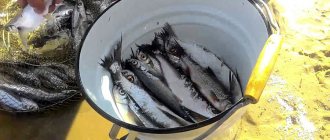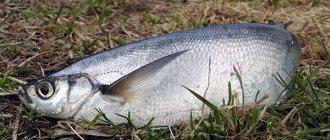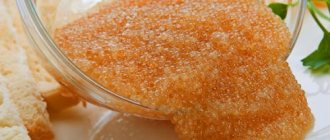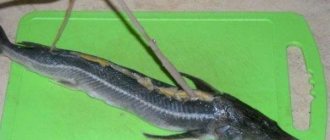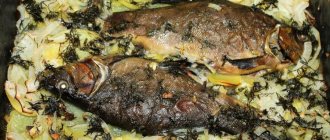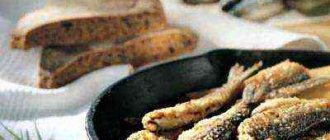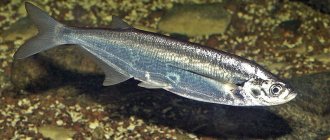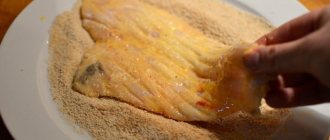Chekhon, which belongs to the carp family, is called differently: Czech, mower, goat. Many even define it as a saber fish, because it is characterized by an unusual shape. The inhabitant of rivers has a flat back and a large elongated abdomen. This is a small fish ─ it is possible to catch sabrefish weighing over half a kilogram, but such a “holiday” happens very rarely. Despite its modest size, it has an amazing taste and excellent aroma. Today, there are many ways to cook chekhon ─ the recipes are very diverse: in the oven, in a slow cooker and in a frying pan. That fish makes wonderful canned food. And dried and dried sabrefish will not leave any gourmet indifferent - it is an ideal snack for beer.
How to fry fish
Universal recipe ─ sabrefish with potatoes. This dish is worthy even of a festive table. List of required ingredients:
- fish ─ 700-800 g (about 2 pieces);
- potatoes ─ 8 pcs.;
- vegetable oil ─ 50 g;
- spices (ground black pepper, salt);
- breading flour ─ 100 g.
The method of preparing the dish is quite simple. First you need to clean the fish from scales and remove the insides, rinse it thoroughly under running water. Then each carcass must be salted and left for about half an hour. This time is enough to peel the potatoes. The vegetable should be cut into slices.
To prepare chekhon we use a frying pan into which you need to pour 20–30 ml of vegetable oil. In a separate container, mix spices and breading flour, roll the fish in this mixture. Chekhon is fried quite quickly until golden brown - about 6-8 minutes on each side. To remove excess drops of vegetable oil, place the finished dish on paper napkins. Place the potatoes in the frying pan where the carcasses were fried. It should be cooked until golden brown. It is recommended to salt potatoes only at the end of the cooking process. After adding spices to the vegetable, place the fried carcasses on top, cover the frying pan with a lid and leave to simmer for about another quarter of an hour. The potatoes will be well saturated with the aroma of fish. The result is fried (but not crispy) sabrefish with a delicious side dish.
Another original and popular recipe is fish schnitzels. To prepare the dish you will need:
- sabrefish ─ 1,000 grams;
- eggs ─ 2 pieces;
- milk ─ 250 ml;
- breading flour ─ 125 g;
- vegetable oil ─ 30 g;
- greens (dill, parsley, green onions) ─ 20 g of each type;
- spices (salt, pepper).
Before cooking, the saberfish should be cleaned (remove scales, entrails, head, tail, fins, ridge with bones) and washed to remove blood. As a result, we get fish fillets, which we sprinkle with spices. Then finely chop the greens. Sprinkle a cutting board with a layer of breading flour and place the fillets on it. Sprinkle the latter generously with chopped herbs and cover with the other half. In a separate container, prepare the batter ─ beat eggs with milk and a pinch of spices. First roll the resulting schnitzels in breading flour and then dip them in batter. Repeat the procedure 2 times. Schnitzels are fried until golden brown in a frying pan for about 10 minutes on each side. As a filling, you can use not only chopped herbs, but also finely chopped vegetables (carrots), mushrooms, and grated cheese.
See also:
- Winter roach fishing
- Catching pike perch with sprat in winter
- Winter fishing for pike perch on girders
Cooking features
Chekhon can be prepared in different ways, and the technology for creating dishes from it can have significant differences. In order to avoid mistakes and get the expected result, you must follow the recommendations that accompany the selected recipe. However, there are several important points that will not hurt the cook to know and take into account, regardless of what recipe he is going to use for preparing chekhon.
- To prepare various dishes, it is advisable to use fresh sabrefish, especially when it comes to drying this fish. However, if you are sure that the product was frozen fresh, it can also be used for culinary purposes. It is only important to allow the fish to thaw in natural conditions, without exposing it to sudden temperature changes. Trying to speed up the process using a microwave or hot water will cause the fish to lose some of its moisture content, causing it to lose its inherent juiciness.
- The most delicious sabrefish are those caught in spring or autumn, since at this time the fish contains the maximum amount of fat.
- It is recommended to salt and dry the whole sabrefish, unless we are talking about specimens weighing more than 0.5 kg. This allows you to retain the fat inside, making the snack as tasty as possible.
- The sanitary fish is dried and salted without removing the scales. In other cases, it is recommended to clean the fish using a knife or a special grater. Manipulation is carried out in the direction from the tail to the head.
- If you plan to fry or bake sabrefish, then it should be gutted. This should be done carefully so as not to damage the gallbladder, otherwise the fish will acquire an unpleasant bitter taste. When gutting a sabrefish, the head, tail, and fins are also usually removed. The fish is then washed to remove the blood. If sabrefish are gutted to dry, the head and fins are not cut off, but it still doesn’t hurt to remove the gills.
- Chekhon is a fairly bony fish. With prolonged baking or marinating, this disadvantage is eliminated, as the bones soften. They don’t interfere with minced cutlets either. If you want to fry saber fish, it doesn’t hurt to marinate it first so that the bones become softer; this will greatly improve the organoleptic qualities of the food.
Delicious saber cutlets
This fish itself is not fatty, therefore, to make a tasty dish, it is recommended to add lard to the minced meat. List of required ingredients:
- sabrefish fillet ─ 1 kg;
- lard or fat ─ 200 g;
- onions ─ 2–4 pieces;
- semolina ─ 200 g;
- eggs ─ 2 pieces;
- breadcrumbs ─ 200 g;
- vegetable oil ─ 100 g;
- spices (pepper, salt).
The cooking process consists of several stages. The algorithm of actions is as follows:
- prepare minced meat from fillet, lard and onions using a meat grinder;
- add spices, eggs and semolina to it, leave for 10 minutes;
- mix the minced meat thoroughly until it becomes a homogeneous white mass;
- form cutlets (be sure to use wet hands);
- roll them in breadcrumbs;
- fry in a saucepan until golden brown.

Secret: place the cutlets in a frying pan only in well-heated oil.
So, the dish is ready. The ideal side dish for it is potatoes: mashed or boiled.
The second recipe for making cutlets involves using the following products:
- sabrefish fillet ─ 800 g;
- egg ─ 1 piece;
- dill and onion greens ─ 3-4 branches each;
- breading flour ─ 200 g;
- onion ─ 1 piece;
- vegetable oil ─ 100 g;
- spices (salt, pepper, cloves, curry).
First, using a meat grinder, prepare minced fish fillet and onion. Then add an egg, finely chopped herbs, and spices to it. Next, we form cutlets from the minced meat, roll them in breading flour and fry in a frying pan until golden brown for about 10 minutes.
This delicately flavored dish will ideally complement the diet of both children and adults. It is also suitable for those who are on a diet. Tasty and very healthy!
Preparing the fish
It is recommended to use freshly caught fish, then the result will be not only aromatic, but also preserved all the delights of the taste of saberfish. You can smoke fish whole or flat, cleaned or not.
Clean and plaster
We follow the following procedure for preparing fish:
- We gut the carcasses. We carry out this operation by cutting the abdomen extremely carefully. Otherwise, the integrity of the gallbladder can be damaged, and this threatens to leak bile into the meat, which will give it bitterness and make it inedible. You will have to rinse it for a long time and thoroughly.
- We wash the carcasses thoroughly. To do this, we use cold water and napkins, which we use to dry the abdomen after removing the film and blood clots. We remove the fins: caudal and anal.
- We flatten large carcasses using a knife. We cut along the spine, cutting the rib bones and dividing the carcass into two parts. The head is also cut, if it remains.
- Remove bones and gills. It is necessary to remove the ribs and ridge, as well as the gills - this will contribute to better preservation of the product.
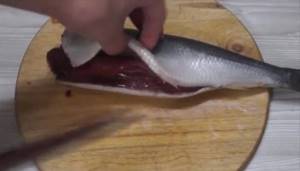
It is not recommended to smoke ungutted sabrefish, as it will have an unpleasant odor and a bitter taste.
Salting methods
Before smoking, salt is used to remove excess moisture. To salt sabrefish, one of two methods is used:
Dry pickling. Rub medium-fine salt (150 g of salt per 1 kg of fish) into the walls of the peritoneum and pour into the gills. The fish is placed tightly in a container that does not oxidize (a wooden box or basket with a lined bottom). The fish is sprinkled with salt between the rows and on top by about 10 mm. There should be a pressure on top of the semi-finished products, which with its weight will squeeze the juice out of the fish, and it will flow through the bars of the basket. Normal salting requires at least 24 hours and a temperature within 2-4°C degrees. To give better taste to the salt, you can add black pepper, garlic, and ginger.
Wet Ambassador. For those who are doing salting for the first time, this option is the most acceptable:
- Place the fish, belly side up, in a container (you can use large pots, buckets or basins) in tight rows.
- Sprinkle with salt and sugar (1 kg of sugar per 1 kg of salt), per 1 kg of fish you need 100 g of the mixture.
- Place a weight on top.
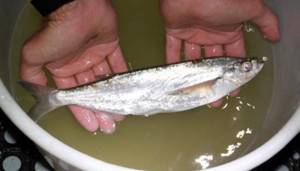
The fish will be salted in the secreted juice for 2-3 days. Choose a cool place for storage.
The following wet salting method is also used:
- Pre-boil the brine mixture in a 10 to 1 ratio of water and salt. For taste and smell, add black and red pepper, garlic, bay leaf.
- Cool and dip the saberfish prepared for salting into the brine.
- They are pressed on top with something massive and kept in the refrigerator for 2-3 days. From time to time the raw materials are turned over.
Soaking and drying
To prevent salt from appearing on the fish during smoking, it should be rinsed with cold running water after salting. If the sabrefish turns out to be too salty, the procedure is carried out within 3 hours. If stagnant water is used, it is changed regularly - at least 5 times. After soaking is completed, the carcasses are dried using napkins.
The best recipe for quick baked fish
Chekhon cooked in the oven is a very juicy dish. This culinary masterpiece is good with any sauce and vegetables. To prepare the dish you will need:
- fish ─ 0.5 kg;
- milk ─ 50 g;
- breadcrumbs ─ 30 g;
- oil ─ 2 tbsp. l.;
- spices (pepper, salt).
First of all, you should clean the casing from entrails and scales and wash it thoroughly. Then divide it into portions and dip it in salted milk. Next, roll the pieces in breadcrumbs and place on a baking sheet, previously generously greased with vegetable oil. Bake in the oven for about a quarter of an hour at 180 degrees. Preheat the cabinet ─ 5 minutes.
Video: Recipe for making delicious saber fish
Cold smoking
For cold smoking, a smoke generator is used. You must adhere to the following algorithm of actions:
- Fill the body with alder chips, cherry, apple and pear branches. It is not recommended to use coniferous wood chips; they smoke. Moisten them if they are too dry before storing. Do not apply too much wood-based materials to avoid bitterness in the sabrefish meat and a strong smoked smell.
- Connect the smoke generator. Place the fish prepared for smoking into the chamber. Carcasses should be placed on a grill greased with vegetable oil, belly down, or hung on hooks. The distance between each fish is at least a centimeter so that the sides are baked.
- Close the lid, start the compressor to inject smoke.
- Smoke at 25-30°C degrees for 8 hours to one and a half days, depending on the size of the carcasses.
- Gradually cool the finished product, leaving the fish in a used smokehouse or hanging it outside, ensuring protection from flies. It will take 24 hours for the fat to redistribute and strong odors to disappear.
Recipe for canned food in a slow cooker
Today you won’t surprise anyone with canned vegetables and fruits. But saber fish prepared in this way will be a worthy decoration for the festive table for New Year or Christmas.
You will need:
- 2 large sabrefish;
- 3 medium sized onions;
- 2 carrots;
- 50 g vegetable oil;
- spices (salt, ground black pepper to your taste);
- laurel;
- a few black peppercorns;
- 200 ml boiling water.
We clean, gut and wash the sanitary fish, then cut it into large pieces, salt and pepper to taste. To soak the meat in spices, leave it in a cold place for about 2 hours. Chop the onion into half rings. Cut the carrots into thin strips. The process of preparing canned food in a slow cooker:
- turn on the device to the “Frying” mode for half an hour;
- heat the bowl for about 2-3 minutes, add vegetable oil;
- fry the onion until golden brown;
- add carrots and simmer for 5 minutes;
- lay out pieces of fish;
- add a few black peppercorns and bay leaves;
- pour a glass of boiled water on top;
- close the lid of the multicooker and wait for the end of the “Frying” program.
Then select the “Quenching” operating mode for an hour and a half. Set the pressure to “3”. After the sound signal that the dish is ready, let the fish simmer for another couple of hours. We put the canned food in a clean jar, which must first be sterilized, and roll it up.
Video: How to cook canned food in oil in a pressure cooker
Secrets of marinating
Cold fish dishes on almost any holiday table come in second place after meat dishes. Well, what if it’s pickled sabrefish? The saberfish is sure to delight your guests.
List of required ingredients:
- fresh sabrefish ─ 10 fish;
- white wine vinegar ─ 30 ml;
- olive oil ─ 100 ml;
- smoked paprika ─ 10 g;
- Sichuan pepper ─ 1 tsp;
- corn oil ─ 100 ml;
- allspice ─ 5 peas;
- bay leaf ─ 3 leaves;
- salt ─ 300 g;
- pink pepper ─ a few peas.
The process of preparing pickled sabrefish consists of two stages. The first is preparing the fish. The casserole must be cleaned and washed thoroughly, and dried with a napkin. Spread 100 g of salt in an even layer on the bottom of the container. Then the fish carcasses should be laid out on it. Next, you need to fill the saberfish with the remaining salt, close the container with a lid and move it to a cold room for a couple of days.
The second stage is preparing the marinade. All of the above spices should be ground in a blender and then mixed with vinegar and oil.
The third stage is marinating the saberfish. Remove the fish from the container, wash and dry with a paper towel. Place the carcasses in the marinade for two days. After a day they can be turned over to the other side. Marinated saber fish turns out very aromatic and tasty. Before serving, you can garnish it with pink pepper.
Marinated sabrefish
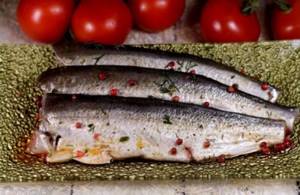
Compound:
- sabrefish – 1 kg;
- salt – 150 g;
- grape vinegar (6 percent) – 20 ml;
- olive oil – 50 ml;
- corn oil – 50 ml;
- paprika – 5 g;
- Sichuan pepper – a pinch;
- allspice peas – 3 pcs.;
- pink pepper – 3 pcs.;
- bay leaf – 1 pc.
- Wash the saberfish.
- Pour 50 g of salt into the bottom of the container, place the fish in it, cover with salt, using about 50 g. Place in a cool place for 48 hours.
- Place the spices in a special mill and grind. You can also use a coffee grinder to grind spices.
- Mix the spices with the remaining salt, vinegar and two types of vegetable oil.
- Remove the fish from the salt and shake it off. Add to marinade and stir. The sauce should cover the fish on all sides.
- Place the container with the saber cap in the refrigerator. Marinate for 2 days. After a day, it doesn’t hurt to turn the fish on the other side for better salting.
Before serving, the pickled saber fish must be gutted, cut into pieces, discarding the tail and head, and placed in a herring bowl. It's a good idea to garnish the fish with onions or lemon wedges.
How to salt chekhon
The fish of the carp family is very bony. Therefore, small specimens are most often salted. There are two main ways to prepare them. This is dry and wet salting.
Secret: small-sized carcasses are cooked ungutted. The subcutaneous fat of the fish will saturate the meat well, making it more tender and tasty.
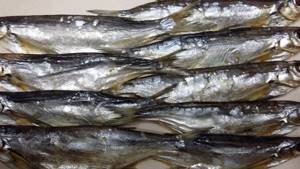
To salt sabrefish dryly at home, you should prepare a large pan into which to pour salt (layer thickness ─ 1 cm). The fish must first be washed and dried with a paper towel. How much to salt carcasses? For 1 kg of sabrefish, it is enough to take 150 g of spice. The fish carcasses are placed tightly on the salt layer with the belly up. Sprinkle generously with salt on top. Then cover the container with a lid and put pressure on it.
Carcasses should be stacked so that large fish are on the bottom, and small specimens are on top.
How many days does it take to salt chekhon? Small specimens will be ready for consumption in 4 days. But large ones - only in 10 days. Check the readiness of the fish by the hardness of the back and the color of the eyes. The first should be elastic, the second ─ light red. To remove excess salt from carcasses, they are soaked for 12 hours.
How to pickle sabrefish in saline solution? For this cooking method, in addition to fish, you will need the following ingredients:
- salt ─ 1 kg;
- sugar ─ 1 tbsp. l.;
- water ─ 3 l.
Prepare a solution from these ingredients. Mix it thoroughly until the spices are completely dissolved. Sugar plays a very important role - it makes the meat more tender.
Thoroughly washed fish are placed in a container. Then they are filled with saline solution for about a week. Small specimens will be ready in 5 days. Then the fish is soaked and dried.
Video: How to properly pickle saber fish at home
Spicy salted saberfish has a special taste. To prepare aromatic fish, you will need to stock up on the following ingredients:
- small carcasses of river inhabitants ─ 2 kg;
- boiling water ─ 1 l;
- coarse salt ─ 100 g;
- sugar ─ 25 g;
- vinegar ─ 25 ml;
- bay leaf ─ 2 leaves;
- allspice ─ a few peas;
- ground coriander ─ ½ teaspoon;
- cloves ─ 1 pinch;
- ground black pepper ─ ½ teaspoon;
- dried herbs, garlic ─ 1 tbsp. l. mixtures;
- chili pepper ─ 1 small pod.
Place the washed, gutted and dried sabrefish into a container of the appropriate size and sprinkle it with coarse salt. It is not recommended to use the fine fraction, since it is unable to draw liquid out of carcasses well, and besides, it makes the fish over-salted.
To prepare the brine, put a pan of water on the fire. Then add a spoonful of sugar and two salts. When the water boils, add the remaining spices and bay leaves to the brine. Boiling time ─ 5 minutes. It is not recommended to keep the brine on the stove longer, as the spices will lose their aroma. Cool the liquid and pour it over the fish. Chekhon will be ready on the fourth or fifth day. It is advisable that she stay in a cold room all this time.
How to cook chekhon - list of recipes
Below is a list of dishes that can be easily prepared from chekhon at home. Each recipe is accompanied by a small image and a short summary. To get acquainted with the full description of the preparation of the dish you like, you need to click on its name and go to the page where all the culinary secrets of its preparation are revealed.
How to fry fish. Two options: 1) Chekhon with potatoes - frying breaded fish and frying potatoes in fish oil. It turns out to be fish with a side dish. 2) Schnitzels made from boneless fish stuffed with herbs (cheese, vegetables), in an egg-milk mixture, fried on both sides in a frying pan.
Fishermen express the opinion that it is not worth preparing first courses of sabrefish from low-calorie meat; fish soup made from it is uncooked and tasteless. The opinion is controversial. Let us explain why it is worth boiling fish soup. The recipe page describes the preparation method and lists the ingredients: vegetables, herbs, spices.
How to cook sabrefish by grinding it in a meat grinder along with the bones. A good way to get a tasty dish and not have to worry about removing seeds. Two recipes for delicious cutlets. 1) With the addition of fresh lard, onions, semolina. 2) With green onions, fresh dill, various spices.
Preparing fish for smoking: cleaning, removing bones, flaking. Types of salting, choice of salting method. Washing, soaking, drying. A detailed description of the method of cold smoking saber fish. Hanging in a smoking apparatus, maintaining temperature parameters and time.
Chekhon. A recipe for preparing spicy salted fish with a step-by-step explanation of the stages of salting fish. What is better to put in brine - saturated saline solution. The best spices for spicy salting: coarse salt, peppercorns and allspice, coriander grains or powder, cloves, bay leaves.
Canned sabrefish dishes in reserve. Options for preparing delicious canned food: 1) In tomato puree, ground pumpkin seeds and spices. 2) Canned marinated fish with onion rings. 3) With the addition of vegetable oil. 4) With vegetables - carrots and onions.
How to prepare saber fish with a simple method of withering. Cutting carcasses before salting. Choice of salting methods. Soaking salted fish. Hanging to dry, protecting fish from insects. Bringing it to the required condition. Optimal drying time. Packaging and storage of dried fish.
This page presents the sabrefish. Recipes for preparing dishes from sabrefish, as well as detailed lists of recipes from numerous other types of river fish, can be found in the “Fisherman’s Kitchen” section.
Follow us on social networks
— through them we publish a lot of interesting information, photos and videos.
Popular sections of the site:
The fisherman's calendar will allow you to understand how all the fish bite depending on the time of year and month.
The fishing gear page will tell you about many popular gear and devices for fishing.
Fishing baits - we describe in detail live, plant, artificial and unusual ones.
In the bait article you will get acquainted with the main types, as well as tactics for using them.
Learn all the fishing lures to become a real fisherman and learn how to choose the right one.
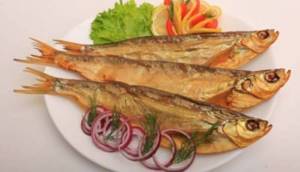
The saberfish is so coveted by fishermen that in some regions its population is under control. However, in other places this fish is classified as a commercial fish, and it can become the prey of a successful fisherman legally. Tender, fatty, very tasty and healthy saber fish is in demand in cooking. Most often it is dried or salted, but it can also be fried, baked, or made into cutlets. If you are lucky with your catch, and a significant part of it is this elongated, shiny fish, it won’t hurt you to learn how to cook sabrefish to highlight its unique taste.
How to dry saber fish correctly
It is recommended to cook fish in this way in the autumn or spring, since it is at this time that it has a good layer of fat. The withering process includes several stages:
- preparing fish and suitable containers;
- salting carcasses (you can use dry or wet salting method);
- soaking fish;
- drying carcasses;
- drying of saberfish.
Tip: to speed up this process, you should hang the fish head down (this way the juice drains better) on a strong rope in a dry, well-ventilated room. After two days, change its position. That is, from now on it should hang tail down. It is recommended to dry the carcasses for one and a half weeks.
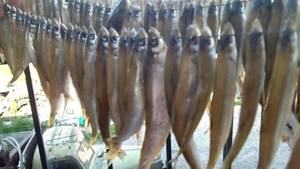
How to dry sabre
Small specimens are suitable for this cooking method; they should not be gutted. It is only important to thoroughly wash the river fish. Next, you should properly salt the casserole for drying. To do this, place the carcasses tightly in a large container and add salt by eye. It is better to take a large fraction spice.
Fish should only be salted with rock salt. Iodized one is not suitable, because it will give the saber fish a characteristic taste.
Fish should be salted for up to 10 days. Then it must be soaked for 10 hours and dried. Next, the carcasses should be wiped with a mixture of vinegar and unrefined oil. Then hang the saberfish on a fishing line in a dry room. How long does it take to dry fish? This process takes about a week if the carcasses are small. Drying is faster if the fish is hung in a well-ventilated area.
To protect the saberfish from the invasion of flies, it should be wrapped in gauze, which is pre-moistened in vinegar diluted in water.
Features of the variety
What kind of variety is this? This is a semi-anadromous, schooling type fish. Belongs to the carp family. Its other names are widespread:
The individual received such names for its external characteristics. It is distinguished by a saber-shaped narrow body, the length of which does not exceed 60 cm. The saber fish weighs from 300 to 500 g, but not more than 2 kg.
Spawning of the individual begins in early May, but by the middle of the first summer month it ends when the water temperature reaches 15 degrees or more. This process is preceded by a mass migration of fish. During this period, large schools of Czech fish follow the flow of rivers.
At such a time (as well as during the autumn period) you can catch a large number of sablica. On the Volga, a rubber band is used for this. This is a special bottom tackle. Czech fish are well caught using a float rod or spinning rod with a worm or maggot.
Calorie content and beneficial properties
Chekhon is a dietary product. The calorie content of fish is 88 kcal per 100 g. In addition, sabrefish is hypoallergenic, so it is recommended to include it in the diet and children's diet.
The meat of the river dweller has high nutritional value. The benefit to humans is expressed in the enrichment of the body with nutrients:
- fluorine ─ takes part in the formation of bone tissue;
- zinc ─ promotes normal functioning of the central nervous system;
- chromium ─ stabilizes blood cholesterol levels;
- nickel ─ activates cell growth and restoration;
- molybdenum ─ promotes the removal of uric acid from the body.
Chekhon fillet contains protein compounds, vitamins and other useful substances. When included in the diet, metabolic processes improve and blood sugar and cholesterol levels stabilize.
To correctly assess the benefits and harms of fish, you should familiarize yourself with the contraindications to its consumption. It is not advisable to include salted, pickled and dried sabrefish in the diet for people suffering from diseases of the digestive system. If you still want to enjoy it, eat foods that have undergone heat treatment. If you are prone to allergies to fish protein or have an individual intolerance to the product, it is not recommended to include it in your diet.
Dried sabrefish at home
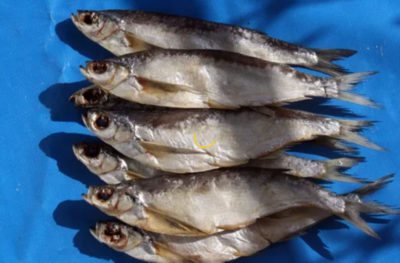
Compound:
- Wash the casing and let it dry. Remove the gills.
- Mix salt and sugar, pour some of this mixture onto the bottom of a plastic container so that it forms about a centimeter layer.
- Place the fish on the bottom of the container, sprinkling each layer with the sugar-salt mixture.
- Cover the fish with a lid slightly smaller than the container. Place a brick wrapped in cloth on top or place a jar filled with water.
- Place the container with fish in a cool place. Salt it for 4-10 days depending on its weight (about 2 days per 100 g of fish). The readiness of the fish can be determined by the density of the back - it should become firm and elastic.
- Remove the fish from the container, shake off the salt, place in a container with clean water for 10 hours. During this time, it is advisable to change the water 2-3 times.
- After soaking, hang the fish on a fishing line or twine, wrap it in gauze to protect it from insects and leave in a cool, well-ventilated place for 7-14 days.
We work for you
To replenish your supply of sabrefish, go fishing. The recreation center "Uglyanskoe" will provide you with the best conditions for a comfortable and fun pastime. If necessary, our rangers will organize master classes and demonstrate photos and video materials. At your service:
- comfortable rooms;
- sauna;
- restaurant with European and Russian cuisine;
- pool;
- karaoke club;
- bar;
- powerful flotilla;
- specially equipped courts for playing volleyball, basketball, darts, billiards, table tennis.
Rest assured: the Uglyanskoye recreation center will offer interesting entertainment for everyone!
